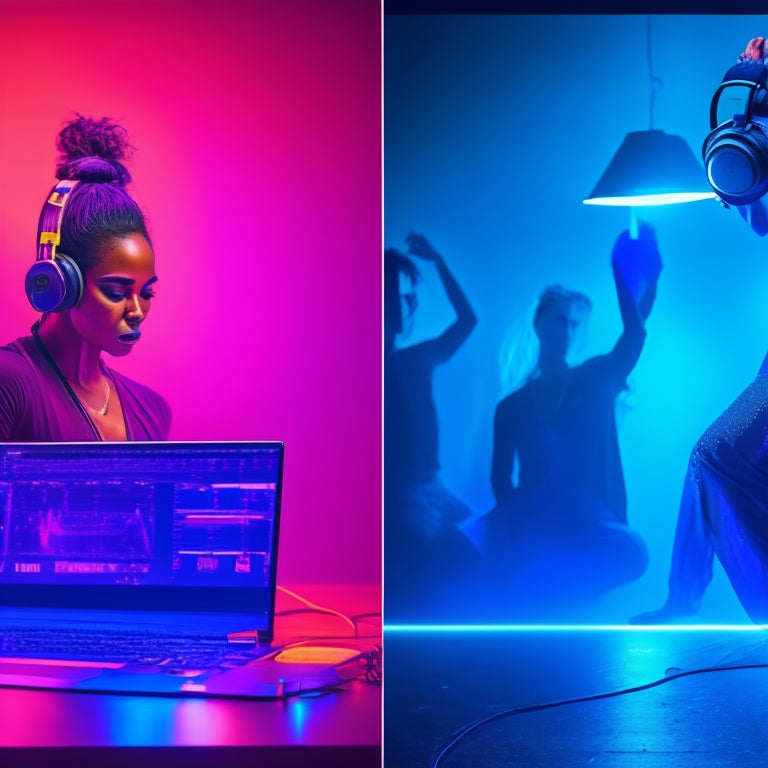
Why Music Editing Is a Game-Changer for Choreographers
Share
By refining the rhythm, tempo, and texture of your music, you can access a new level of creative expression, elevating your choreography from mere movement to a harmonious fusion of sound and motion. You'll discover how to create a nuanced soundscape that perfectly complements your choreography, craft smooth shifts, and amplify emotional impact with fades. With expertly layered soundscapes and beat manipulation, you'll infuse your choreography with kinetic energy and guide your audience through a transcendent experience. As you master the art of music editing, you'll uncover the secrets to transporting your audience to new heights - and that's just the beginning.
Key Takeaways
• Music editing enables choreographers to create a nuanced soundscape by adjusting rhythmic phrases to match choreography, amplifying emotional impact.
• Seamless transitions and smooth flow are achieved through crossfades, tempo adjustments, and ambient pads, ensuring audience immersion.
• Fades and dynamic silence can heighten tension, suspense, and emotional intensity, elevating the choreography to a transcendent experience.
• Layering diverse textures and timbres creates a rich, multidimensional soundscape, conveying narrative elements and adding depth to the performance.
• Beat manipulation injects kinetic energy, builds tension, and guides the audience through ups and downs, making the choreography more engaging and dynamic.
Enhancing Musicality With Rhythmic Adjustments
By subtly tweaking the rhythm of your music, you can create a more nuanced and expressive soundscape that elevates your choreography and draws your audience in. Think of it as a masterful dance between sound and movement – when the rhythm is on point, the whole performance comes alive!
To achieve this harmonious union, focus on melodic phrasing, where you adjust the length and emphasis of musical phrases to mirror the energy and flow of your choreography. This might mean stretching out a phrase to match a dramatic arm extension or clipping it short to punctuate a sharp, staccato movement.
Harmonic accents can also add a layer of depth and complexity to your music. Try emphasizing certain chords or notes to highlight specific moments in your choreography – a dramatic drop, a soaring leap, or a tender pause.
Smoothening Transitions for Seamless Flow
As you weave together disparate musical elements, a seamless flow becomes essential, and that's where smoothing connections come into play, helping you to eliminate jarring cuts and awkward pauses that can disrupt the visual narrative of your choreography.
You want your audience to be fully immersed in the performance, not jarred out of the zone by abrupt shifts. That's where silky segues and harmonious bridges come in – the secret sauce to creating a cohesive and engaging show.
To achieve a seamless flow, follow these tips:
-
Use crossfades: Gradually fade out one track while fading in the next to create a smooth, uninterrupted flow.
-
Employ tempo adjustments: Make subtle tempo changes to maintain a consistent pace and energy throughout the performance.
-
Add ambient pads: Use ambient pads or textures to fill gaps and create a sense of continuity between sections.
Amplifying Emotional Impact With Fades
Craft a cinematic soundscape by leveraging fades to amplify the emotional impact of your choreography, drawing your audience into the heart of the performance. You're not just editing music, you're crafting an immersive experience.
Fades are your secret weapon to create Dynamic Silence, where the absence of sound becomes a powerful storytelling tool. By strategically fading in or out, you can heighten tension, create suspense, or evoke a sense of longing. Think of it as painting with sound – the subtle gradations of volume and texture can evoke a visceral response from your audience.
Don't underestimate the power of a well-placed fade to shift the Sonic Texture of your piece. A gradual fade-out can create a sense of resolution, while a sudden fade-in can jolt your audience back to attention. By mastering the art of fades, you can elevate your choreography from mere movement to a transcendent experience that leaves a lasting impression on your audience.
Creating Unique Soundscapes With Layers
With three to five distinct layers, you can orchestrate a rich, multidimensional soundscape that synergistically complements your choreography, propelling your audience into the narrative. By crafting a sonic tapestry with diverse textures, you'll create an immersive experience that draws the audience in.
Think of it as building a sonic sandwich: each layer adds depth, complexity, and emotional resonance to the overall soundscape.
Here are three ways to elevate your layering game:
-
Texture exploration: Experiment with contrasting timbres, from haunting whispers to soaring synths. This will add visual-like depth to your soundscape, making it feel more cinematic.
-
Sonic storytelling: Use layers to convey narrative elements, such as a pulsing heartbeat for tension or a soaring melody for triumph. This will help the audience connect emotionally with your choreography.
-
Frequency manipulation: Balance your layers across the frequency spectrum to create a sense of space and clarity. This secures that each element shines without overpowering the others.
Maximizing Energy With Beat Manipulation
By expertly manipulating beats, you can inject your choreography with kinetic energy, creating an infectious rhythm that electrifies your audience and propels them into the performance. Think of it as a shot of adrenaline straight into the heart of your dance piece.
By tweaking the tempo, you can build tension, creating an anticipation that's almost palpable. Suddenly, you drop the beat, and the audience is left breathless. It's like a rollercoaster of emotions, and you're the conductor, expertly guiding them through the ups and downs.
Dynamic shifts in rhythm can also add an extra layer of excitement to your choreography. Imagine a slow-burning intro that suddenly gives way to a frenetic pace, leaving the audience gasping for air. It's like a one-two punch of energy, and it's all thanks to your mastery of beat manipulation.
Frequently Asked Questions
Can I Edit Music Without Altering the Original Composition's Integrity?
Like a master chef tweaking a recipe, you wield artistic license to edit music without sacrificing the original's integrity, embracing creative freedom to season the composition with your unique flair, all while keeping the essence intact.
How Do I Avoid Copyright Issues When Editing Commercial Music Tracks?
"When editing commercial tracks, you'll need to navigate licensing options and royalty rates to avoid copyright issues. Secure the necessary permissions, or opt for royalty-free tracks to keep your dance moves drama-free!"
Is Music Editing Software Compatible With Both Mac and Pc?
'Hold your breath, because the answer is about to blow your mind! Yes, most music editing software is cross-platform, undergoing rigorous testing to guarantee seamless operation on both Mac and PC, offering operating system flexibility that's music to your ears!'
Can I Collaborate With Other Choreographers on a Single Music Edit?
"You can totally team up with fellow choreographers on a single music edit, fostering creative partnerships and a collaborative process that's as seamless as your next big dance routine - most music editing software makes it happen!"
Do I Need to Be a Skilled Musician to Effectively Edit Music?
"Did you know 75% of choreographers rely on music editors? You don't need to be a skilled musician to edit music effectively, but having an ear for Musicality Matters. With creative freedom, you can experiment, and that's where the magic happens!"
Related Posts
-

Top Dance Makeup Tools for Perfect Stage Looks
To create a flawless stage look, you'll need the right tools and techniques. Start with high-quality makeup brushes, ...
-

Get Moving: Dance Charades Cards Energize Fun
Dance Charades Cards are the ultimate party sparkplug, igniting a fun-filled frenzy of energetic excitement, funky mo...
-

Newspaper Headline: Access Engaging Social Media Assets Privately
In today's digital landscape, crafting an engaging online presence requires a strategic balance between providing all...


